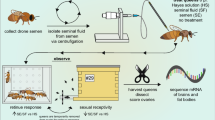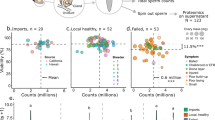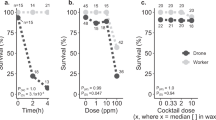Abstract
INSECT chemosterilants can act either by attacking the gamete (direct action) or by interfering with the tissues or nutrients that support the gamete (indirect action)1. It is hard to tell whether the chemosterilant acts directly or indirectly when the developing gamete is under the nutritional and regulatory control of the parent organism. But because adult male insects usually have a full complement of mature spermatozoa immediately after eclosion, only a directly acting chemosterilant should be effective for adult males. The male organism would then serve only as a receptacle for the interaction between the sperm and the chemical. When Herskowitz2 used vaginal douches to insert a mutagen into inseminated female Drosophila, he obtained the first indication of mutagenic effects of a chemical on sperm outside the male organism. Because honey bees, Apis mellifera L., can be successfully fertilized by artificial insemination, we could test the direct action hypothesis by treating bee semen in vitro with the chemosterilant tris(l-aziridmyl)phosphine oxide (tepa) and determining the effect of the treated semen on the reproduction of the queen bees.
This is a preview of subscription content, access via your institution
Access options
Subscribe to this journal
Receive 51 print issues and online access
$199.00 per year
only $3.90 per issue
Buy this article
- Purchase on Springer Link
- Instant access to full article PDF
Prices may be subject to local taxes which are calculated during checkout
Similar content being viewed by others
References
Bořkovec, A. B., Insect Chemosterilants (Interscience Publishers, New York, 1966).
Herskowitz, I. H., Genetics, 41, 605 (1956).
Mackensen, O., and Roberts, W. C., US Dept. Agric. Bur. Entomol. Plant Quarantine, ET-250 (1948).
Chang, S. C., and Bořkovec, A. B., J. Econ. Entomol., 57, 488 (1964).
Taber, S., and Blum, M. S., Science, 131, 1734 (1960).
Mackensen, O., J. Econ. Entomol., 36, 465 (1943).
Author information
Authors and Affiliations
Rights and permissions
About this article
Cite this article
TABER, S., BOŘKOVEC, A. Chemical Sterilization of Honey Bee Spermatozoa in vitro. Nature 224, 1217–1218 (1969). https://doi.org/10.1038/2241217a0
Received:
Issue Date:
DOI: https://doi.org/10.1038/2241217a0
Comments
By submitting a comment you agree to abide by our Terms and Community Guidelines. If you find something abusive or that does not comply with our terms or guidelines please flag it as inappropriate.



